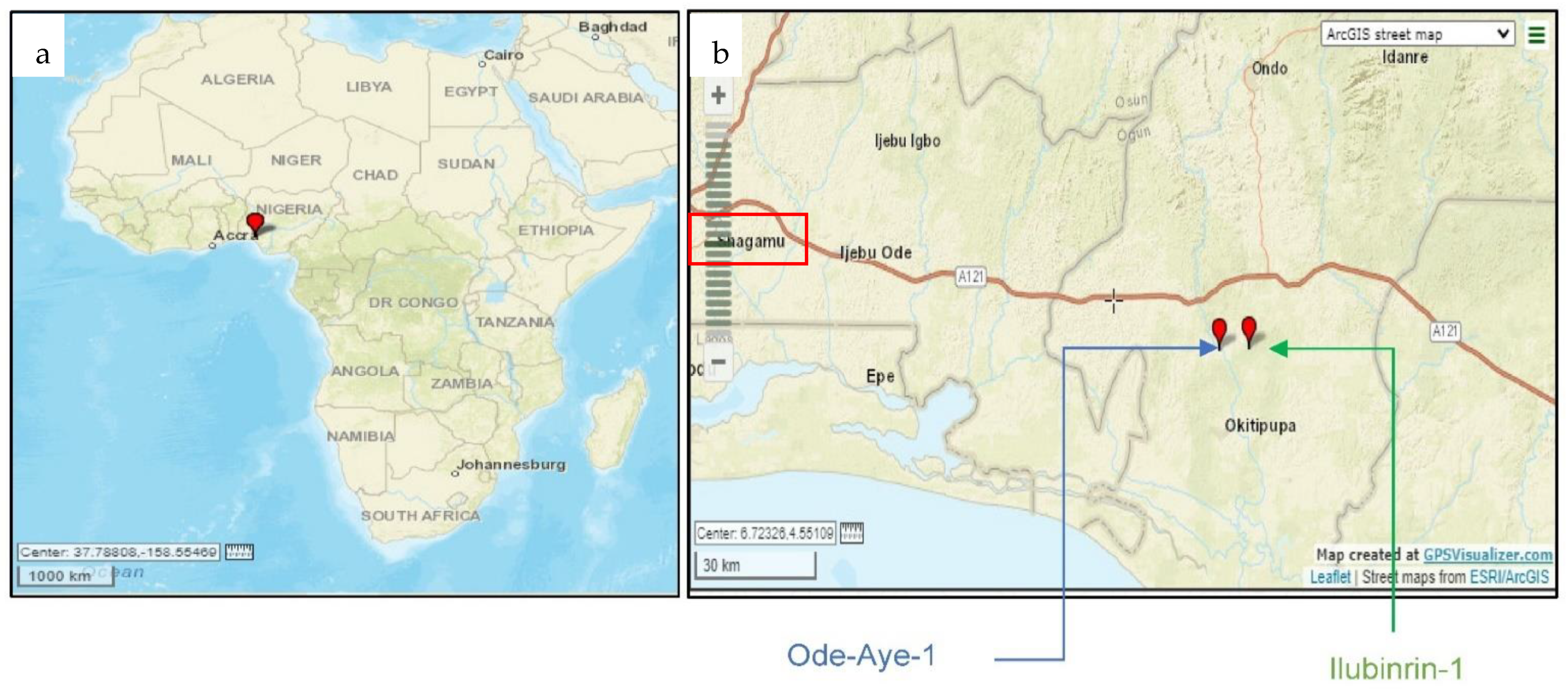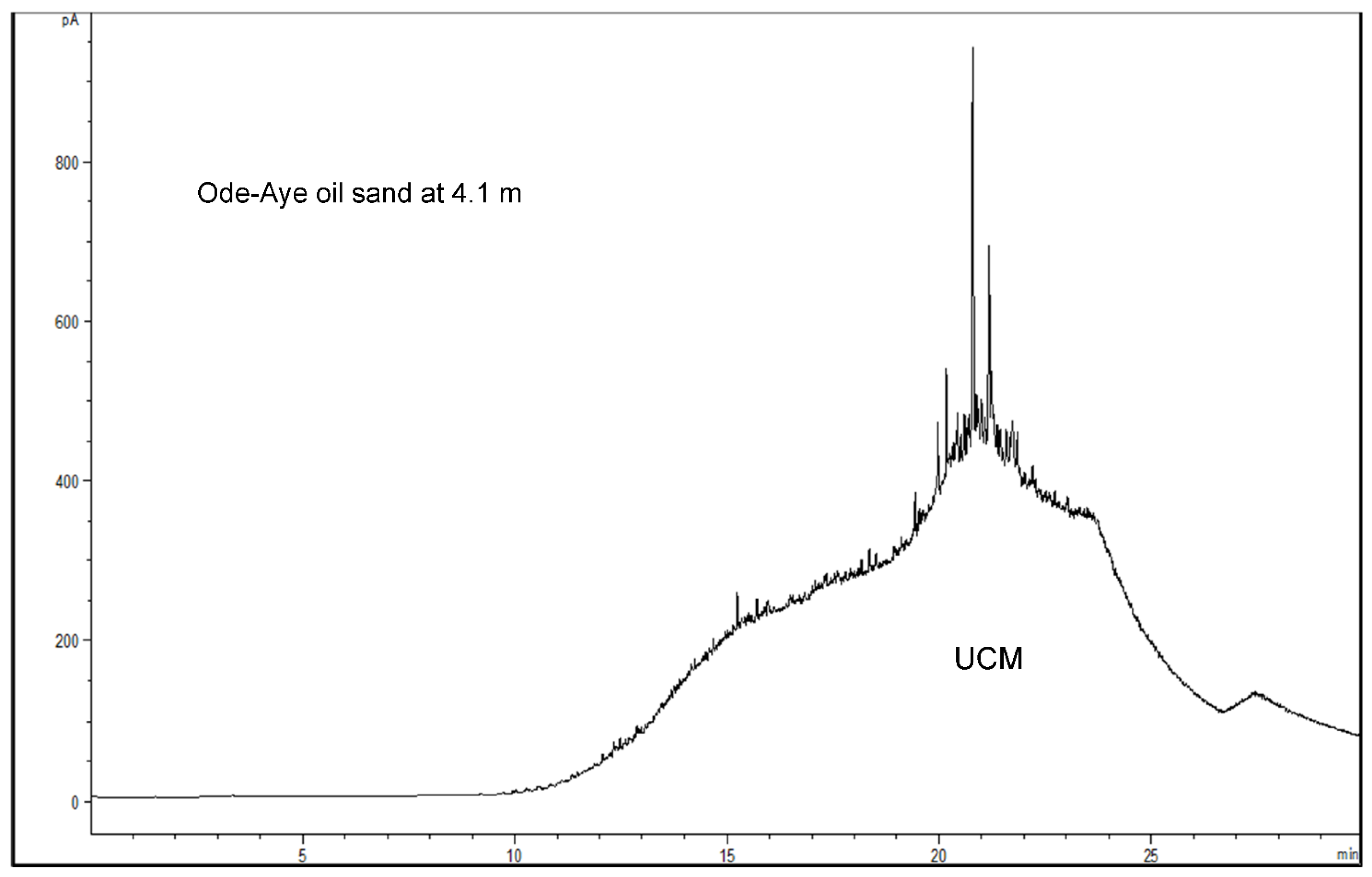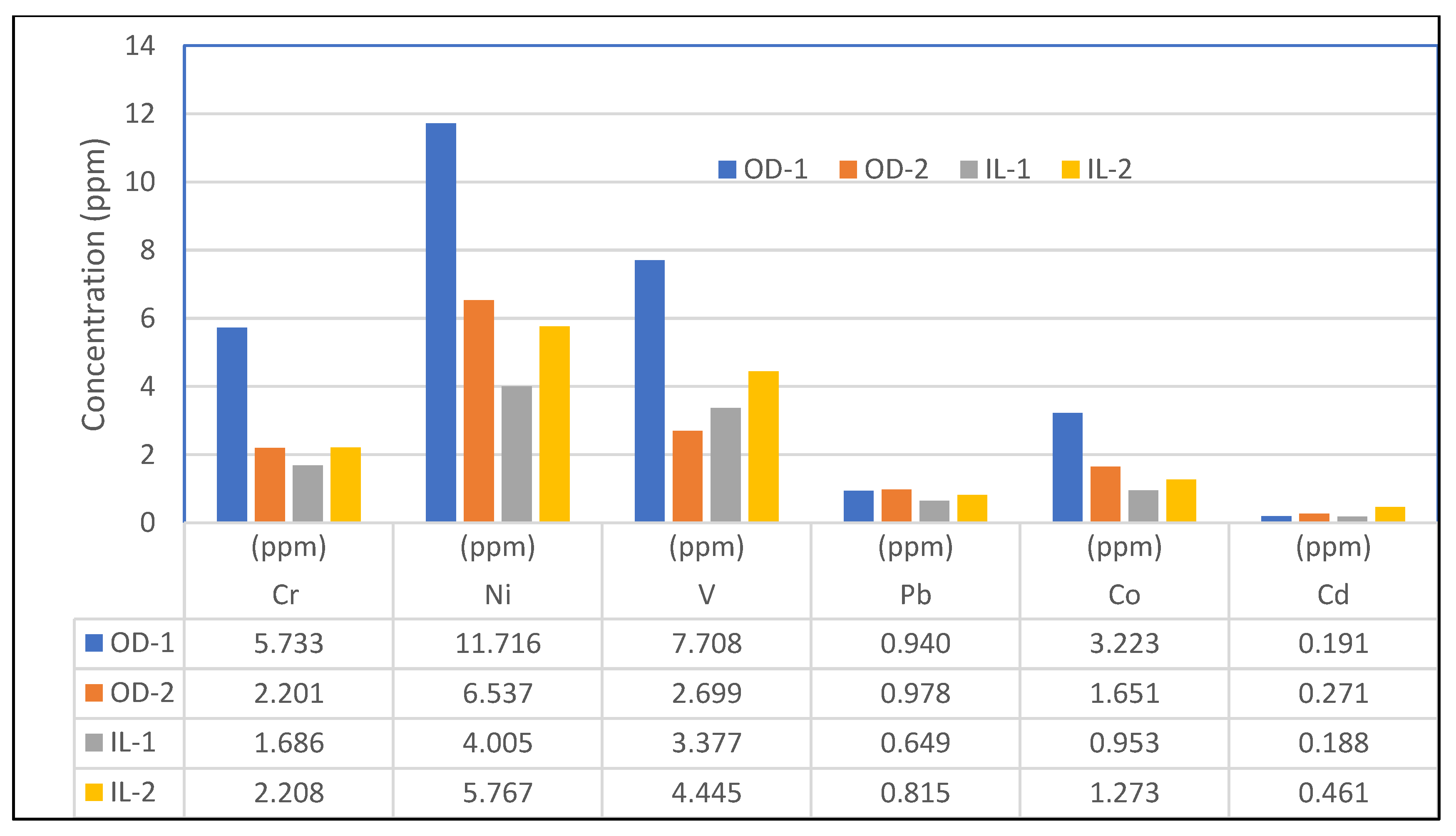Metal–Metal Correlation of Biodegraded Crude Oil and Associated Economic Crops from the Eastern Dahomey Basin, Nigeria
Abstract
1. Introduction
2. Materials and Methods
2.1. Thermal Desorption-Gas Chromatography (TD-GC)
2.2. Acid Digestion
2.3. Atomic Absorption Spectrometry
3. Results
4. Discussion
5. Conclusions
- (1)
- The TD-GC results indicated severely altered oil. The hydrocarbon composition analysis showed a dominance of heavy-end hydrocarbon fractions, and the chromatograms showed no detectable hydrocarbon below 10 min retention time due to the absence of light-end fractions. In addition, the chromatograms illustrated the classical humps of the unresolved complex mixtures (UCM), indicating heavily altered crude oil.
- (2)
- The geochemical data from the A.A.S showed a close relationship in the concentrations of Cr, Ni, V, Pb, Co, and Cd in the oil sands and plants, suggesting a good correlation.
- (3)
- The concentration of the metals in the oil sand agreed with the biodegraded signatures presented by gas chromatography, implying that the metal concentration in crude oil may increase with increasing biodegradation.
- (4)
- The World Health Organization’s (WHO) recommended safe and permissible limits for these metals in agricultural soils were exceeded by the oil sands.
- (5)
- The toxic effects of the heavy metals absorbed by the plants may have accelerated their mortality.
Author Contributions
Funding
Data Availability Statement
Acknowledgments
Conflicts of Interest
References
- Brownfield, M.E.; Charpentier, R.E. Geology and Total Petroleum Systems of the Gulf of Guinea Province of West Africa; Bulletin; USGS: Reston, VA, USA, 2006; p. 32.
- Falufosi, M.O.; Osinowo, O.O. Geology and Hydrocarbon Potential of the Nigerian Sector of Dahomey Basin. J. Sediment. Environ. 2021, 6, 335–358. [Google Scholar] [CrossRef]
- Omatsola, M.E.; Adegoke, O.S. Tectonic Evolution and Cretaceous Stratigraphy of the Dahomey Basin. Niger. J. Min. Geol. 1981, 18, 130–137. [Google Scholar]
- Fadiya, S.L.; Coker, S.J.L.; Ekun, O.A.; Fadiya, M.O.; Ariyo, T.S. ‘Danian/Maastrichtian Hiatus’: A Basin-Wide Event in the Eastern Benin (Dahomey) Basin, Nigeria Based on Evidence from Calcareous Nannofossils. J. Afr. Earth Sci. 2021, 179, 104178. [Google Scholar] [CrossRef]
- Obaje, N.G. Geology and Mineral Resources of Nigeria; Springer: Berlin/Heidelberg, Germany, 2009. [Google Scholar]
- Oli, I.C.; Okeke, O.C.; Abiahu, C.M.G.; Anifowose, F.A.; Fagorite, V.I. A Review of the Geology and Mineral Resources of Dahomey Basin, Southwestern Nigeria. Int. J. Environ. Sci. Nat. Resour. 2019, 21, 556055. [Google Scholar] [CrossRef]
- Nton, M.E.; Ikhane, P.R.; Tijani, M.N. Aspect of Rock-Eval Studies of the Maastrichtian-Eocene Sediments from Subsurface, in the Eastern Dahomey Basin Southwestern Nigeria. Eur. J. Sci. Res. 2009, 25, 417–427. [Google Scholar]
- Mohammed, S.; Opuwari, M.; Titinchi, S.; Bata, T.; Mohammed, B.A. Evaluation of Source Rock Potential and Hydrocarbon Composition of Oil Sand and Associated Clay Deposits from the Eastern Dahomey Basin, Nigeria. J. Afr. Earth Sci. 2019, 160, 103603. [Google Scholar] [CrossRef]
- Ministry of Mines and Steel Development (MMSD). Tarsands & Bitumen Investment Opportunities in Abuja, Nigeria; MMSD: Madison, WI, USA, 2009.
- Curtis, C.; Kopper, R.; Decoster, E.; Guzmán-Garcia, A.; Huggins, C.; Knauer, L.; Minner, M.; Kupsch, N.; Linares, L.M.; Rough, H.; et al. Heavy-Oil Reservoirs. Oilfield Rev. 2002, 14, 30–51. [Google Scholar]
- Dembicki, H., Jr. Practical Petroleum Geochemistry for Exploration and Production; Elsevier: Amsterdam, The Netherlands, 2017. [Google Scholar]
- Adebiyi, F.M.; Yoade, R.O. Thermodynamic Study of the Removal of Heavy Metal Ions from Heavy Oils Using Tetramethyl Ammonium Hydroxide Pentahydrate Ionic Liquid. Pet. Res. 2021. [Google Scholar] [CrossRef]
- Ore, O.T.; Adeola, A.O. Toxic Metals in Oil Sands: Review of Human Health Implications, Environmental Impact, and Potential Remediation Using Membrane-Based Approach. Energy Ecol. Environ. 2021, 6, 81–91. [Google Scholar] [CrossRef]
- Wenger, L.M.; Isaksen, G.H. Control of Hydrocarbon Seepage Intensity on Level of Biodegradation in Sea Bottom Sediments. Org. Geochem. 2002, 33, 1277–1292. [Google Scholar] [CrossRef]
- Onojake, M.C.; Osuji, L.C.; Ndubuka, C.O. Characterization of Bitumen Samples from Four Deposits in Southwest, Nigeria Using Trace Metals. Egypt. J. Pet. 2017, 26, 547–552. [Google Scholar] [CrossRef][Green Version]
- de Abreu, C.R.; de Souza, E.S.; Martins, L.L.; Cordeiro, T.C.; Carrasquilla, A.A.G.; Guimarães, A.O. Application of the Electron Spin Resonance Technique in the Characterization of Brazilian Oils: Correlation with Their Biodegradation Level and Polar Composition. Energy Fuels 2020, 34, 13837–13848. [Google Scholar] [CrossRef]
- Babel, S.; Kurniawan, T.A. Low-Cost Adsorbents for Heavy Metals Uptake from Contaminated Water: A Review. J. Hazard. Mater. 2003, 97, 219–243. [Google Scholar] [CrossRef]
- Corral-Bobadilla, M.; González-Marcos, A.; Alba-Elías, F.; de Santo Domingo, E.D. Valorization of Bio-Waste for the Removal of Aluminum from Industrial Wastewater. J. Clean. Prod. 2020, 264, 121608. [Google Scholar] [CrossRef]
- Rahman, Z.; Singh, V.P. The Relative Impact of Toxic Heavy Metals (THMs) (Arsenic (As), Cadmium (Cd), Chromium (Cr)(VI), Mercury (Hg), and Lead (Pb)) on the Total Environment: An Overview. Environ. Monit. Assess. 2019, 191, 419. [Google Scholar] [CrossRef] [PubMed]
- Klett, T.R.; Ahlbrandt, T.S.; Schmoker, J.W.; Dolton, G.L. Ranking of the World’s Oil and Gas Provinces by Known Petroleum Volumes; U.S. Dept. of the Interior, Geological Survey: Reston, VA, USA, 1997.
- d’Almeida, G.A.F.; Kaki, C.; Adeoye, J.A. Benin and Western Nigeria Offshore Basins: A Stratigraphic Nomenclature Comparison. Int. J. Geosci. 2016, 7, 177–188. [Google Scholar] [CrossRef]
- Coker, S.J.; Ejedawe, J.E.; Oshiorienua, J.A. Hydrocarbon Source Potentials of Cretaceous Rocks of Okitipupa Uplift, Nigeria. Niger. J. Min. Geol 1983, 22, 163–169. [Google Scholar]
- Mohammed, S.; Opuwari, M.; Titinchi, S. Source Rock Evaluation of Afowo Clay Type from the Eastern DahomeyBasin, Nigeria: Insights from Different Measurements. Sci. Rep. 2020, 10, 12036. [Google Scholar] [CrossRef]
- Elueze, A.A.; Nton, M.E. Organic Geochemical Appraisal of Limestone and Shales in Part of Eastern Dahomey Basin, Southwestern Nigeria. Niger. J. Min. Geol. 2004, 40, 29–40. [Google Scholar] [CrossRef]
- Nwajide, C.S. Geology of Nigeria’s Sedimentary Basins; CSS Bookshops Ltd.: Lagos, Nigeria, 2013. [Google Scholar]
- Kimbrough, D.E.; Wakakuwa, J.R. Acid Digestion for Sediments, Sludges, Soils, and Solid Wastes. A Proposed Alternative to EPA SW 846 Method 3050. Environ. Sci. Technol. 1989, 23, 898–900. [Google Scholar] [CrossRef]
- EPA. Compendium of Methods for the Determination of Toxic Organic Compounds in Ambient Air; EPA: Cincinnati, OH, USA, 1999.
- Uddin, A.B.M.H.; Khalid, R.S.; Alaama, M.; Abdualkader, A.M.; Kasmuri, A.; Abbas, S.A. Comparative Study of Three Digestion Methods for Elemental Analysis in Traditional Medicine Products Using Atomic Absorption Spectrometry. J. Anal. Sci. Technol. 2016, 7, 1–7. [Google Scholar] [CrossRef]
- Curiale, J.A. Distribution and Occurrence of Metals in Heavy Crude Oils and Solid Bitumens–Implications for Petroleum Exploration: Section II. Characterization, Maturation, and Degradation. In Exploration for Heavy Crude Oil and Natural Bitumen; American Association of Petroleum Geologists: Tulsa, OK, USA, 1987. [Google Scholar]
- Tissot, B.P.; Welte, D.H. Petroleum Formation and Occurrence; Springer: Heidelberg, Germany; New York, NY, USA, 1984; ISBN 978-3-642-87815-2. [Google Scholar]
- Kinuthia, G.K.; Ngure, V.; Beti, D.; Lugalia, R.; Wangila, A.; Kamau, L. Levels of Heavy Metals in Wastewater and Soil Samples from Open Drainage Channels in Nairobi, Kenya: Community Health Implication. Sci. Rep. 2020, 10, 8434. [Google Scholar] [CrossRef] [PubMed]
- Chiroma, T.M.; Ebewele, R.O.; Hymore, F.K. Comparative Assessment of Heavy Metal Levels in Soil, Vegetables and Urban Grey Waste Water Used for Irrigation in Yola and Kano. Int. Refereed J. Eng. Sci. 2014, 3, 1–9. [Google Scholar]
- Sallau, A.; Momoh, A.; Opuwari, M.; Akinyemi, S.; Lar, U. An Overview of Trace Elements in Soils of Keana-Awe Brine-Fields, Middle Benue Trough, Nigeria. Trans. R. Soc. S. Afr. 2017, 72, 47–54. [Google Scholar] [CrossRef]
- Momoh, A.; Rotji, E.P.; Odewumi, S.C.; Opuwari, M.; Ojo, O.J.; Olorunyomi, A. Preliminary Investigation of Trace Elements in Acid Mine Drainage from Odagbo Coal Mine, North Central, Nigeria. J. Environ. Earth Sci. 2017, 7, 1–7. [Google Scholar]
- Chang, C.Y.; Yu, H.Y.; Chen, J.J.; Li, F.B. Accumulation of Heavy Metals in Leaf Vegetables from Agricultural Soils and Associated Potential Health Risks in the Pearl River Delta, South China. Environ. Monit. Assess. 2014, 186, 1547–1560. [Google Scholar] [CrossRef]
- Zunaidi, A.A.; Lim, L.H.; Metali, F. Transfer of Heavy Metals from Soils to Curly Mustard (Brassica juncea (L.) Czern.) Grown in an Agricultural Farm in Brunei Darussalam. Heliyon 2021, 7, e07945. [Google Scholar] [CrossRef]
- Okoro, E.E.; Okolie, A.G.; Sanni, S.E.; Omeje, M. Toxicology of Heavy Metals to Subsurface Lithofacies and Drillers during Drilling of Hydrocarbon Wells. Sci. Rep. 2020, 10, 6152. [Google Scholar] [CrossRef]
- Anyanwu, E.; Onyele, O. Occurrence and Concentration of Heavy Metals in a Rural Spring in South-Eastern Nigeria. J. Appl. Sci. Environ. Manag. 2018, 22, 1473. [Google Scholar] [CrossRef][Green Version]
- Oyeyemi, K.D.; Aizebeokhai, A.P.; Okagbue, H.I. Geostatistical Exploration of Dataset Assessing the Heavy Metal Contamination in Ewekoro Limestone, Southwestern Nigeria. Data Brief 2017, 14, 110–117. [Google Scholar] [CrossRef]
- Awadh, S.M.; Ali, K.K.; Alazzawi, A.T. Geochemical Exploration Using Surveys of Spring Water, Hydrocarbon and Gas Seepage, and Geobotany for Determining the Surface Extension of Abu-Jir Fault Zone in Iraq: A New Way for Determining Geometrical Shapes of Computational Simulation Models. J. Geochem. Explor. 2013, 124, 218–229. [Google Scholar] [CrossRef]
- Momoh, A.; Opuwari, M.; Patrick, O.E.; Lucky, I.O.; Jimoh, A. Multivariate Statistical Appraisal of Trace Elements in Shallow Groundwater of Keana Nigeria. Environ. Asia 2020, 13, 67–74. [Google Scholar]
- Briffa, J.; Sinagra, E.; Blundell, R. Heliyon Heavy Metal Pollution in the Environment and Their Toxicological Effects on Humans. Heliyon 2020, 6, e04691. [Google Scholar] [CrossRef]
- Ahiakwo, C.; Ekweozor, I.K.E.; Onwuteaka, J.N.; Anaero-Nweke, G.N.; Ugbomeh, A.P.; Bobmanuel, K.N.O. Evaluation of Heavy Metal (Zn, Cu, Pb, Cr, Cd and Ni) Concentrations in the Leaves, Stems and Roots of Telfairia Occidentalis (Fluted Pumpkin) Harvested from the Egi Community, Rivers State. Int. J. Sci. Res. 2019, 8, 419–425. [Google Scholar]
- Haider, F.U.; Liqun, C.; Coulter, J.A.; Cheema, S.A.; Wu, J.; Zhang, R.; Wenjun, M.; Farooq, M. Cadmium Toxicity in Plants: Impacts and Remediation Strategies. Ecotoxicol. Environ. Saf. 2021, 211, 111887. [Google Scholar] [CrossRef] [PubMed]
- Danish, S.; Kiran, S.; Fahad, S.; Ahmad, N.; Ali, M.A.; Tahir, F.A.; Rasheed, M.K.; Shahzad, K.; Li, X.; Wang, D.; et al. Alleviation of Chromium Toxicity in Maize by Fe Fortification and Chromium Tolerant ACC Deaminase Producing Plant Growth Promoting Rhizobacteria. Ecotoxicol. Environ. Saf. 2019, 185, 109706. [Google Scholar] [CrossRef] [PubMed]
- Kotapati, K.V.; Palaka, B.K.; Ampasala, D.R. Alleviation of Nickel Toxicity in Finger Millet (Eleusine coracana L.) Germinating Seedlings by Exogenous Application of Salicylic Acid and Nitric Oxide. Crop J. 2017, 5, 240–250. [Google Scholar] [CrossRef]
- Asia, I.O.; Jegede, S.I.; Jegede, D.A.; Ize-Iyamu, O.K.; Akpasubi, E.B. The Effects of Petroleum Exploration and Production Operations on the Heavy Metals Contents of Soil and Groundwater in the Niger Delta. Int. J. Phys. Sci. 2007, 2, 271–275. [Google Scholar]








| Era | Period | Epoch | Stratigraphy of the Eastern Dahomey Basin | ||
|---|---|---|---|---|---|
| Cenozoic | Quaternary | Holocene | Jones and Hockey (1964) | Omatsola & Adegoke (1981) | |
| Pleistocene | |||||
| Tertiary | Oligocene | Coastal Plain Sands | Coastal Plain Sands | ||
| Eocene | Ilaro Formation | Ilaro Formation | |||
| Ososhun Formation | |||||
| Paleocene | Ewekoro Formation | Akinbo Formation | |||
| Ewekoro Formation | |||||
| Mesozoic | Cretaceous | Late to Early | Abeokuta Formation | Abeokuta Group | Araromi Formation |
| Afowo Formation | |||||
| Ise Formation | |||||
| Sample ID | Formation | Sample Type | Sample Depth (m) | Paraffins | % Naphthenes | % Aromatics | |
|---|---|---|---|---|---|---|---|
| % Light Condensate | % Heavy Condensate | ||||||
| OD-1 | Afowo | Oil Sand | 2.50 | 2.03 | 95.32 | 0.11 | 0.08 |
| OD-2 | Afowo | Oil Sand | 4.10 | 0.58 | 96.59 | 0.00 | 0.00 |
| IL-1 | Afowo | Oil Sand | 2.00 | 0.40 | 98.32 | 0.00 | 0.00 |
| IL-2 | Afowo | Oil Sand | 3.10 | 0.59 | 97.54 | 0.40 | 0.07 |
| Sample ID | Sample Depth | Cr | Ni | V | Pb | Co | Cd |
|---|---|---|---|---|---|---|---|
| Oil Sands | (m) | (ppm) | (ppm) | (ppm) | (ppm) | (ppm) | (ppm) |
| OD-1 | 2.5 | 5.733 | 11.716 | 7.708 | 0.940 | 3.223 | 0.191 |
| OD-2 | 4.1 | 2.201 | 6.537 | 2.699 | 0.978 | 1.651 | 0.271 |
| IL-1 | 2.0 | 1.686 | 4.005 | 3.377 | 0.649 | 0.953 | 0.188 |
| IL-2 | 3.1 | 2.208 | 5.767 | 4.445 | 0.815 | 1.273 | 0.461 |
| Range | 1.686–5.733 | 4.005–11.716 | 2.699–7.708 | 0.649–0.978 | 0.953–3.223 | 0.188–0.461 | |
| Mean±SD | 2.957 ± 1.866 | 7.006 ± 3.313 | 4.557 ± 2.220 | 0.845 ± 0.148 | 1.77 ± 1.006 | 0.277 ± 0.128 | |
| Plant Roots | |||||||
| Orange | N/A | 7.475 | 4.981 | 0.551 | 0.001 | 0.806 | 0.177 |
| Cocoa | N/A | 7.095 | 16.697 | 2.151 | 0.023 | 3.942 | 0.254 |
| Oil Palm | N/A | 32.685 | 32.423 | 11.983 | 0.190 | 4.425 | 0.262 |
| Kola | N/A | 9.687 | 9.157 | 0.779 | 0.037 | 0.695 | 0.023 |
| Range | 7.095–32.685 | 4.981–32.423 | 0.551–11.983 | 0.001–0.190 | 0.695–4.425 | 0.023–0.262 | |
| Mean±SD | 14.235 ± 12.352 | 15.814 ± 12.087 | 3.866 ± 5.457 | 0.062 ± 0.086 | 2.457 ± 1.507 | 0.179 ± 0.122 |
Publisher’s Note: MDPI stays neutral with regard to jurisdictional claims in published maps and institutional affiliations. |
© 2022 by the authors. Licensee MDPI, Basel, Switzerland. This article is an open access article distributed under the terms and conditions of the Creative Commons Attribution (CC BY) license (https://creativecommons.org/licenses/by/4.0/).
Share and Cite
Mohammed, S.; Opuwari, M.; Titinchi, S.; Cyster, L. Metal–Metal Correlation of Biodegraded Crude Oil and Associated Economic Crops from the Eastern Dahomey Basin, Nigeria. Minerals 2022, 12, 960. https://doi.org/10.3390/min12080960
Mohammed S, Opuwari M, Titinchi S, Cyster L. Metal–Metal Correlation of Biodegraded Crude Oil and Associated Economic Crops from the Eastern Dahomey Basin, Nigeria. Minerals. 2022; 12(8):960. https://doi.org/10.3390/min12080960
Chicago/Turabian StyleMohammed, Saeed, Mimonitu Opuwari, Salam Titinchi, and Lilburne Cyster. 2022. "Metal–Metal Correlation of Biodegraded Crude Oil and Associated Economic Crops from the Eastern Dahomey Basin, Nigeria" Minerals 12, no. 8: 960. https://doi.org/10.3390/min12080960
APA StyleMohammed, S., Opuwari, M., Titinchi, S., & Cyster, L. (2022). Metal–Metal Correlation of Biodegraded Crude Oil and Associated Economic Crops from the Eastern Dahomey Basin, Nigeria. Minerals, 12(8), 960. https://doi.org/10.3390/min12080960







